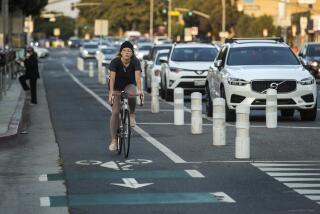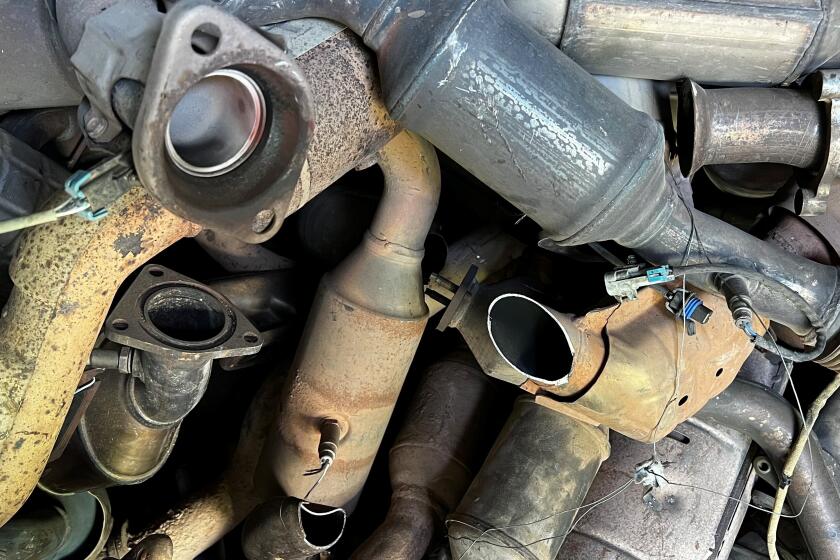Activists sue Los Angeles over Hyperion Bridge design’s single sidewalk

At a June rally, a group protests the $50-million redesign of the Glendale-Hyperion Bridge, which has only one sidewalk.
- Share via
The city of Los Angeles and Caltrans broke state environmental laws when they chose a design that has only one sidewalk for a four-lane bridge connecting Silver Lake and Atwater Village, according to a lawsuit filed Friday.
The suit, filed by a group of local activists, seeks to overturn the Los Angeles City Council’s unanimous approval of a $50-million seismic retrofit of the Glendale Boulevard-Hyperion Avenue Bridge, which spans Interstate 5 and the Los Angeles River. The decision pitted residents and businesses loath to lose a car lane against bicyclists, pedestrian activists and neighborhood groups who said the design would discriminate against the disabled and discourage walking.
The writ of mandate, filed in Los Angeles County Superior Court, says officials should have prepared a full environmental impact report before approving the project. Instead, Los Angeles and Caltrans prepared a document finding no negative environmental impacts.
The lawsuit says the city violated the California Environmental Quality Act and the approval for the design should be overturned because the project will have “significant adverse impacts” on safety and land use.
“It is not Angelenos who are addicted to cars, but our city government that refuses to provide safe, convenient alternatives,” Don Ward, the activist named in the lawsuit, said during a Tuesday news conference.
The historic bridge, built in 1929, has two narrow sidewalks that do not comply with the Americans With Disabilities Act. It does not have bicycle lanes, and is at risk of serious damage in an earthquake.
But adding one, wider sidewalk could violate federal laws protecting access for the disabled, advocates said. A person in a wheelchair or with a walker crossing the bridge to the south side of Atwater Village would have to travel 1,550 feet farther if there were no sidewalk on the other side, according to a technical report prepared for the city by an engineering firm.
An attorney representing the activists said they have not ruled out another lawsuit based on those grounds.
Other pedestrians “will likely risk running across Glendale Boulevard or Hyperion Avenue to reach the sidewalk,” the lawsuit said, “increasing the chance of colliding with a motor vehicle.”
Adding two sidewalks would require taking away a lane of traffic, which concerned some residents and business groups. Some said having only one lane head into Atwater Village would worsen congestion nearby, including on Rowena Avenue, where the city has already taken out a lane to paint a bicycle route. Others said the congestion could become a public safety issue in the event of a major emergency.
The Los Angeles city attorney’s office did not respond to a request seeking comment.
For more Los Angeles transportation news, follow @laura_nelson on Twitter.
More to Read
Sign up for Essential California
The most important California stories and recommendations in your inbox every morning.
You may occasionally receive promotional content from the Los Angeles Times.










